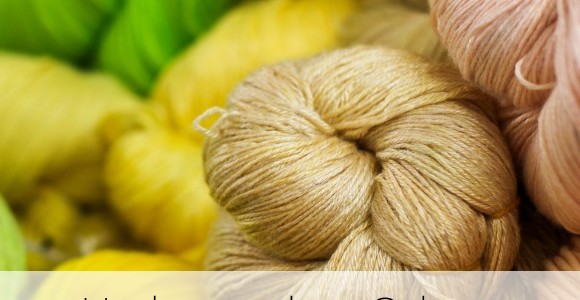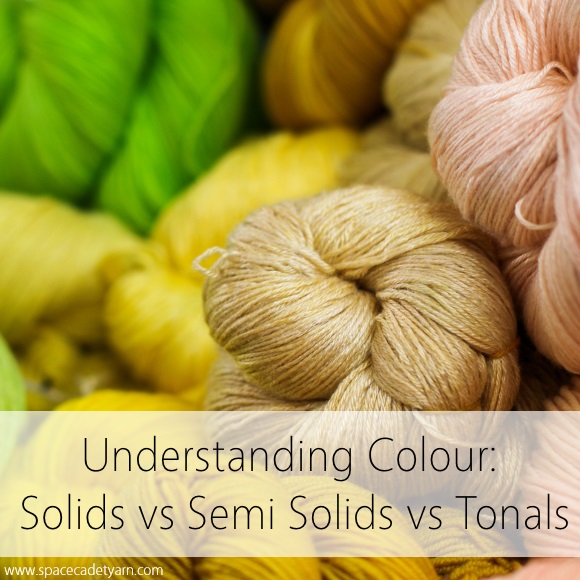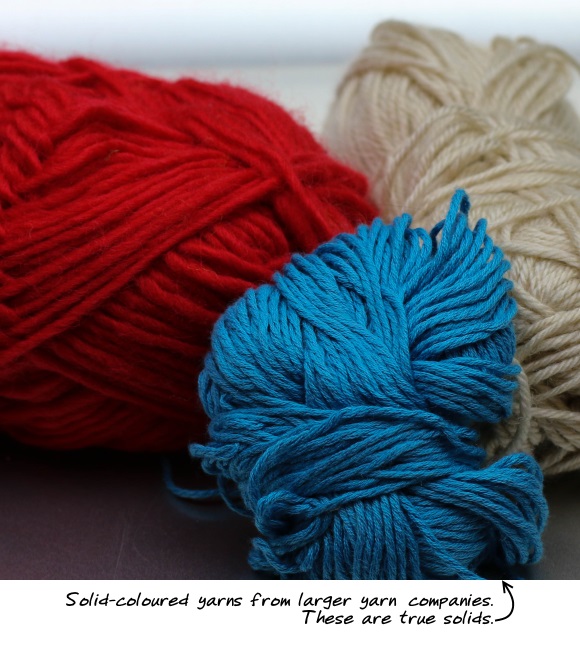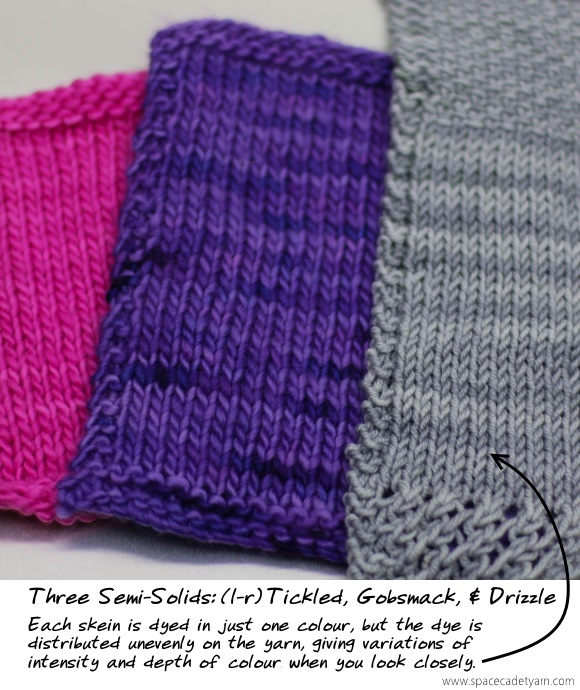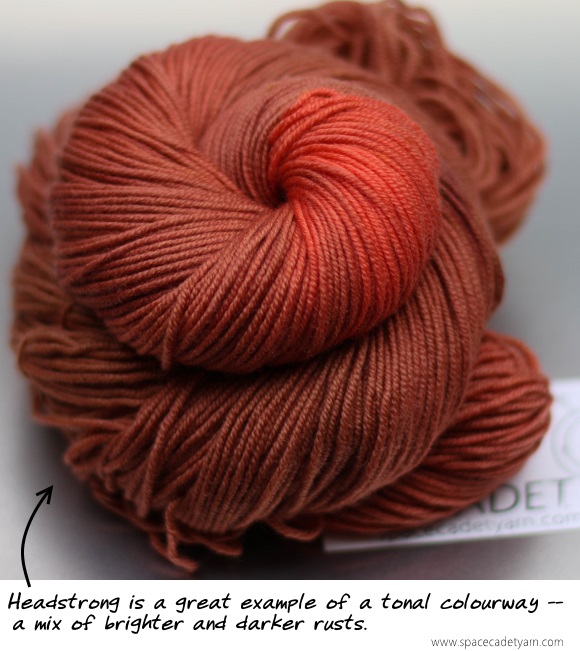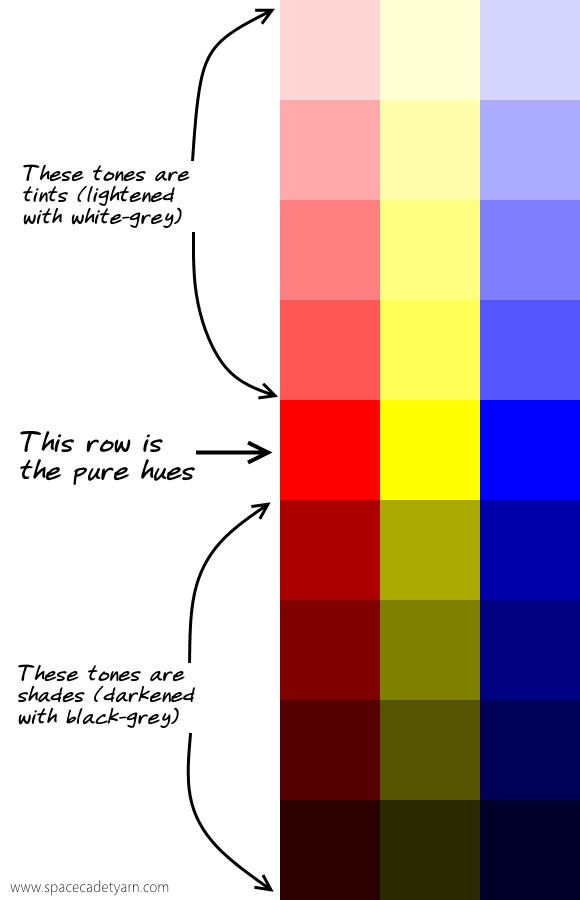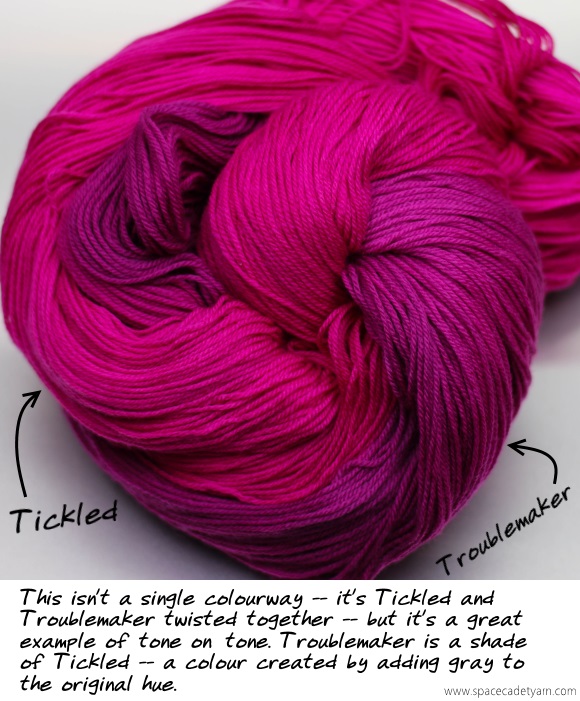An addiction to knitting and crocheting (raise your hand!) might seem like it’s all about the fiber, but it’s really as much about colour. And while lots of folks immediately get schooled up in yarn terms — fingering vs DK, wool vs acrylic, merino vs BFL — there’s a lot of confusion around colour. The terms can be muddling and matching up colourways to patterns can be downright perplexing. I can’t tell you the number of conversations I’ve had with customers at shows where we’re all using the same words (“semi-solid”, “variegated”, “tonal”…) but all at cross-purposes. And so today I start a series of posts to lift that confusion and explain colour terms for hand-dyed yarn.
Ready to get started? First up, three words that sometimes get used interchangeably and sometimes to refer to completely different things: solids vs semi solids vs tonals. Here’s how we use them at SpaceCadet…
Solid Colours (and When a Solid is Not a Solid)
Solid colours are what commercial yarn companies create when they dye in a single hue. You look at a solid skein and you see one, even colour, without variation along the entire length of the yarn. And here’s the key about understanding a solid colour: in natural materials, it can only be achieved by dyeing the fibers before they are spun into yarn, which means it’s usually only larger commercial yarn companies that can create a true solid yarn.
Why? Because it’s the nature of dyeing that the colour is distributed unevenly in the dyebath — to varying degrees, of course. In some dyebaths it’s very obvious that the colour is uneven and in others barely perceptible, but it’s almost impossible to get dye 100%, totally and completely evenly distributed in the water — and therefore on the item being dyed. That means that there will be places where the dye adheres to the fibers more densely (eg, more intensely) than in others, and the result will look uneven.
But the big yarn companies are able to solve this problem by dyeing unspun fiber and then running it through huge blending machines and industrial carders before spinning it into the yarn. The process ensures that any uneven patches are redistributed and the resulting yarn is a beautifully even, solid colour. If you were to pick a commercial yarn apart and compare each individual fiber to another, you might be able to spot some variation, but the overall effect is a yarn in a solid colour.
Semi-Solid Colours (the Solids of the Indie Dyer’s World)
Semi-solid colours are, again, a single hue but this time showing off the natural variation that results from the unevenness of the dyebath. Semi-solids are what you get from hand-dyers — even when dyeing with a single hue, it’s almost impossible for an indie dyeing company to achieve a truly solid colour. Why? Because most indie dyers work with skeins that have been spun by a mill, which means they’re dyeing fiber that is already in yarn form and so, if the dye adheres to the yarn unevenly, there is no way to redistribute the colour to make it even.
And that’s the nature and the allure of hand-dyed yarn. Instead of looking for perfectly even colour, hand-dyed has intriguing depth and beautifully organic variation that makes each yarn truly one-of a kind. In a finished garment, semi-solids will look like a single colour from a distance, but reveal fascinating complexity up close.
Now, do I always faithfully refer to our yarns as “semi-solid”? No, I call them “solid” as often as not because, in regular conversation, it doesn’t make much difference. But if we’re being technical, as we are here, then all our single-colour skeins are semi-solids.
Tonals (and Here’s Where It Gets Tricky)
“Is this a tonal or a semi-solid?” is a question I get asked a lot. It’s often followed by, “Wait… what is a tonal exactly?” I’m not surprised, because the answer is a little technical, but let’s try to keep it simple here.
A colour tone is created by mixing a pure colour (a hue) with a grayscale colour in the range between black and white. So, if you have a pure green, and you mix it with black or an almost-black gray, you’ll get a darker version of that same green, which is called a “shade”. And if you take the pure green again and mix it with white or an almost-white gray, you’ll get a lighter version of that green, called a “tint”. In both cases, it’s still the same hue — the green isn’t any yellower or bluer — it’s just a darker or lighter. Together, the shades and tints (the darker and lighter versions) are the “tones”. Got it?
So a tonal yarn is simply one that incorporates lighter and darker versions of the same colour in the one colourway. It doesn’t have any other hues — no yellower greens or bluer greens — just darker and lighter sections of the exact same colour.
Is that the same as a semi-solid? Well, in some ways, yes. At SpaceCadet, the yarn we dye starts out white(ish) so in those places where the dye doesn’t strike as intensely, what you’re getting is the colour mixed with the white of the yarn — which is a tint. But unless the undyed yarn also has naturally dark gray sections (and ours doesn’t), a typical semi-solid won’t contain any dark tones (shades). So the terms semi-solid and tonal are almost the same thing. Not quite but so close that, in day to day conversation, it probably doesn’t really matter — I tend to use them both without worrying.
There you have it, three words that are often used interchangeably but actually have slightly different meanings. In day-to-day chit chat, the differences probably don’t matter much but, if you want to be as accurate and knowledgeable about the colour of your yarn as you are about its fiber content or construction, then it’s important to understand these details.
Now It’s Your Turn…
So now go and look at your stash — what have you actually got? Do you gravitate toward true solids or do you like the variation and intrigue of semi-solids? Can you find any true tonals, with both lighter and darker tones? Do you love the one-of-a-kind nature of hand-dyed semi-solids?
Up next in this series: understanding variegateds, from gentle to wild. I’ll be posting that sometime in the next week or so — don’t miss it!

